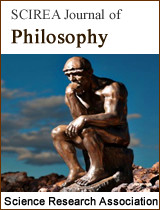The Reductions between/among Aristotelian Syllogisms Based on the Syllogism AII-3
DOI: 10.54647/philosophy720083 60 Downloads 105683 Views
Author(s)
Abstract
With the help of the definitions of the inner and outer negative Aristotelian quantifiers, the symmetry of Aristotelian quantifiers no and some, the anti-syllogism rules and the subsequent weakening rule, this paper illustrates the reducible relations between valid Aristotelian syllogisms of different figures and different forms. More specifically, this paper deduces the remaining 23 valid Aristotelian syllogisms only from the valid syllogism AII-3, and establishes a simple and clear formal axiom system for Aristotelian syllogistic. This formal and innovative research is not only beneficial to the study of reducible relations between other types of syllogisms, such as generalized syllogisms and modal syllogisms, but also to the knowledge representation, knowledge reasoning and natural language information processing in artificial intelligence.
Keywords
Aristotelian syllogisms; axioms; Aristotelian quantifiers; reductions
Cite this paper
Yijiang Hao,
The Reductions between/among Aristotelian Syllogisms Based on the Syllogism AII-3
, SCIREA Journal of Philosophy.
Volume 3, Issue 1, February 2023 | PP. 12-22.
10.54647/philosophy720083
References
| [ 1 ] | Cheng, Z. (2023). How to Deduce the Other 91 Valid Aristotelian Modal Syllogisms from the Syllogism □IA□I-3. Applied Science and Innovative Research, 7(1), 46-57. |
| [ 2 ] | Hui, L. (2023). Reduction between categorical syllogisms based on the syllogism EIO-2. Applied Science and Innovative Research, (7), 30-37. |
| [ 3 ] | Endrullis, J., & Moss, L. S. (2015). Syllogistic logic with ‘Most’ . V. de Paiva et al. (eds. ), Logic, Language, Information, and Computation, 124-139. |
| [ 4 ] | Johnson, F. (2004). Aristotle’s modal syllogisms. Handbook of the History of Logic, I, 247-338. |
| [ 5 ] | Jing, X., and Xiaojun, Z. (2023). The Reducibility of Generalized Modal Syllogisms Based on AMI-1. SCIREA Journal of Philosophy, 3(1): 1-11 |
| [ 6 ] | Long, W. (2023). Formal system of categorical syllogistic logic based on the syllogism AEE-4. Open Journal of Philosophy, (13), 97-103. |
| [ 7 ] | Xiaojun, Z., Hui L., & Yijiang H. (2022), How to Deduce the Remaining 23 Valid Syllogisms from the Validity of the Syllogism EIO-1. Applied and Computational Mathematics, 11(6): 160-164. |
| [ 8 ] | Westerståhl, D. (2007). Quantifiers in Formal and Natural Languages, Handbook of Philosophical Logic. Dordrecht: Kluwer Academic Publishers, (14): 223-338. |
| [ 9 ] | Łukasiewicz, J. (1957). Aristotle’s Syllogistic from the Standpoint of Modern Formal Logic. Oxford: Clarendon Press. |
| [ 10 ] | Mengyao, H., and Xiaojun, Z. (2020). Assertion or rejection of Łukasiewicz’s assertoric syllogism system ŁA. Journal of Chongqing University of Technology (Social Science Edition), (2): 10-18. (in Chinese) |
| [ 11 ] | Peters, S., and Westerståhl, D. (2006). Quantifiers in Language and Logic. Oxford: Claredon Press. |
| [ 12 ] | Halmos P. R. (1974). Naive Set Theory. New York: Springer-Verlag. |
| [ 13 ] | Cori, R., and Lascar D. (2000). Mathematical Logic: Part 1: Propositional Calculuas, Propositional Calculus, Boolean Algebras, Predicate Calculus, Completeness Theorems. Oxford: Oxford Universty Press. |
| [ 14 ] | Hamilton, A. G. (1978). Logic for Mathematicians. Cambridge: Cambridge Universty Press. |
| [ 15 ] | Xiaojun, Z. (2014). Research on the Theory of Generalized Quantifiers. Xiamen: Xiamen University Press. (in Chinese) |

